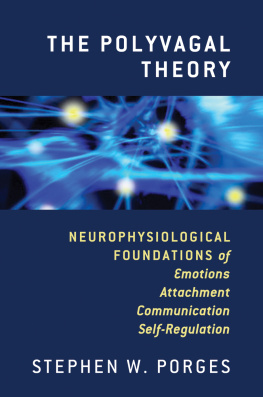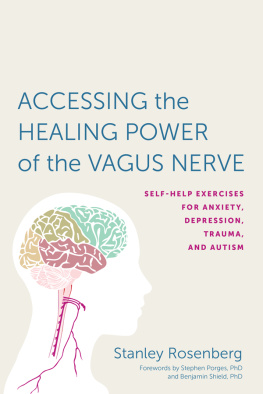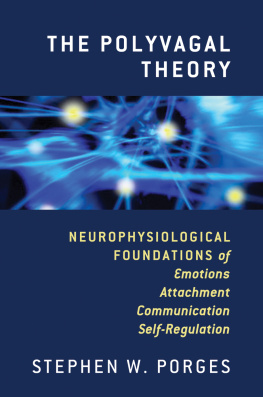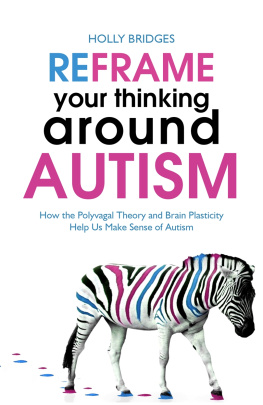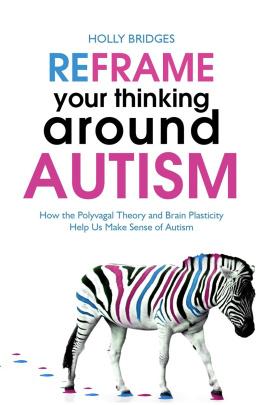
A DDITIONAL A CCLAIM
Stephen Porges PhD has not only made one of the most profound and illuminating contributions to our understanding of nervous system in the last 50 yearshes made one of the most useful ones. Anyone who works with people, or who seeks to heal others, can benefit from his insights. Porges has helped cracked the facial code, and deepened our understanding as to the relationships between our nervous system, our facial expressions and bodily sensations. There has been brilliant work on the relationship between facial expressions and the emotions by Darwin and Ekman. Porges extends these discoveries inward, relating them to the nervous system. What is so special about his contribution, is that it is of immediate clinical import. His principles and discoveries guide us as to how, and when, to intervene in some of the most challenging clinical conditions, and opens up new kinds of treatment possibilities. For decades hes written as a scientist for scientists. Now, in this clear, accessible book, which is an ideal introduction to his ideas, we see what it is like to be in conversation with this brilliant man. This is ideal for clinicians of any kind, but also for anyone who wants to better understand their own nervous system, and that of those they care about.
N ORMAN D OIDGE , MD, AUTHOR , T HE B RAIN T HAT
C HANGES I TSELF , AND T HE B RAIN S W AY OF H EALING
In The Pocket Guide to the Polyvagal Theory , Stephen Porges succeeds, as few researchers do, in the art of deconstructing dense scientific concepts to render them wonderfully accessible to clients, clinicians, and the lay person alike. As the subtleties of the Polyvagal Theory are brought to life through the friendly voice of an innovative genius, a new understanding about the influence of the autonomic nervous system on human behavior emerges, along with neurobiological explanations for a variety of difficulties. You will find that many of the perplexing issues that bring clients to therapy suddenly make biological sense, as well as discover the seeds of bottom-up roadmaps for healing them. Read this book, and be inspired by a revolutionary perspective on the human condition that will have a far-reaching positive impact on your life, your relationships, and your clinical practice.
P AT O GDEN P H D, F OUNDER /E DUCATIONAL D IRECTOR , S ENSORIMOTOR
P SYCHOTHERAPY I NSTITUTE , B OULDER , C OLORADO USA
THE NORTON SERIES ON
INTERPERSONAL NEUROBIOLOGY
Louis Cozolino, PhD, Series Editor
Allan N. Schore, PhD, Series Editor, 20072014
Daniel J. Siegel, MD, Founding Editor
The field of mental health is in a tremendously exciting period of growth and conceptual reorganization. Independent findings from a variety of scientific endeavors are converging in an interdisciplinary view of the mind and mental well-being. An interpersonal neurobiology of human development enables us to understand that the structure and function of the mind and brain are shaped by experiences, especially those involving emotional relationships.
The Norton Series on Interpersonal Neurobiology provides cutting-edge, multidisciplinary views that further our understanding of the complex neurobiology of the human mind. By drawing on a wide range of traditionally independent fields of researchsuch as neurobiology, genetics, memory, attachment, complex systems, anthropology, and evolutionary psychologythese texts offer mental health professionals a review and synthesis of scientific findings often inaccessible to clinicians. The books advance our understanding of human experience by finding the unity of knowledge, or consilience, that emerges with the translation of findings from numerous domains of study into a common language and conceptual framework. The series integrates the best of modern science with the healing art of psychotherapy.
A NORTON PROFESSIONAL BOOK

NOTE TO READERS: Standards of clinical practice and protocol change over time, and no technique or recommendation is guaranteed to be safe or effective in all circumstances. This volume is intended as a general information resource for professionals practicing in the field of psychotherapy and mental health; it is not a substitute for appropriate training, peer review, and/or clinical supervision. Neither the publisher nor the author(s) can guarantee the complete accuracy, efficacy, or appropriateness of any particular recommendation in every respect.
Copyright 2017 by Stephen W. Porges
All rights reserved
First Edition
For information about permission to reproduce selections from this book, write
to Permissions, W. W. Norton & Company, Inc.,
500 Fifth Avenue, New York, NY 10110
For information about special discounts for bulk purchases, please contact
W. W. Norton Special Sales at specialsales@wwnorton.com
or 800-233-4830
Production manager: Christine Critelli
Cover design by Christine Knorr
Cover image Sciepro/Science Photo Library/Corbis
ISBN 978-0-393-70787-8 (pbk.)
ISBN 978-0-393-70853-0 (e-book)
W. W. Norton & Company, Inc.,
500 Fifth Avenue, New York, N.Y. 10110
www.wwnorton.com
W. W. Norton & Company Ltd.,
15 Carlisle Street, London W1D 3BS
TO THE SURVIVORS OF TRAUMA WHO
HEROICALLY SEARCH FOR SAFETY.
CONTENTS
P olyvagal Theory emerged from my research and insights on October 8, 1994 (Porges, 1995). On that date in Atlanta, I described the model with its theoretical implications in my presidential address to the Society for Psychophysiological Research. At that time, I was unaware that the theory would be embraced by clinicians. I had conceptualized the theory as a structure for testable hypotheses within the research community. Consistent with my initial expectations, the theory has had impact in science and has been cited in several thousand peer reviewed publications representing several disciplines. However, the main impact of the theory has been to provide plausible neurophysiological explanations for several of the experiences described by individuals who have experienced trauma. For these individuals the theory provided an understanding of how their bodies were retuned in response to life threat and lost the resilience to return to a state of safety.
Several people have played important roles in helping me translate my ideas into a coherent theory. Foremost, I want to acknowledge my wife, Sue Carter. For more than four decades she has listened, witnessed, and shared ideas that were to become the Polyvagal Theory. Sues landmark work, discovering the role of oxytocin in social bonds, and her general interest in the neurobiology of social behavior served to focus my thinking on the role the autonomic nervous system and physiological state played in not only health, but also in social behavior. Without Sues enduring support, love, and intellectual curiosity, Polyvagal Theory would not have evolved. I am sincerely grateful to Sues contribution.
Unlike many of my colleagues, who treat and study trauma, trauma was not a focus of my research or part of my theoretical agenda. Without traumatologists being interested in Polyvagal Theory, there would not have been an entre for the theory to contribute to the treatment of trauma. This entre was due to three pioneers in traumatology, Peter Levine, Bessel van der Kolk, and Pat Ogden. I graciously acknowledge their influence on my work and their generosity in welcoming me on their journey to understand and rehabilitate the disruptive effects of trauma. It was through their passion to help their clients, their commitment to learn, and their curiosity to understand the processes involved in experiencing and recovering from trauma that they embraced insights from the theory into their treatment models.
Next page

